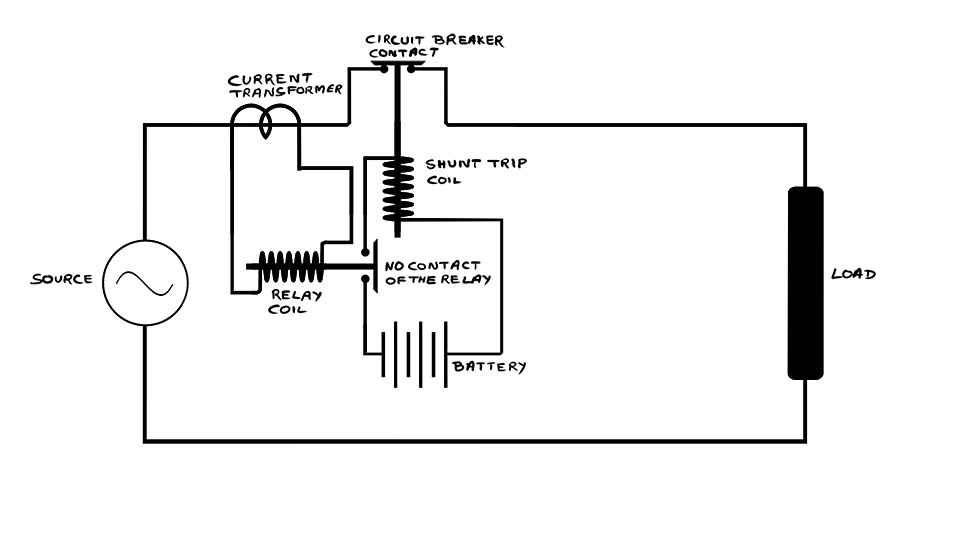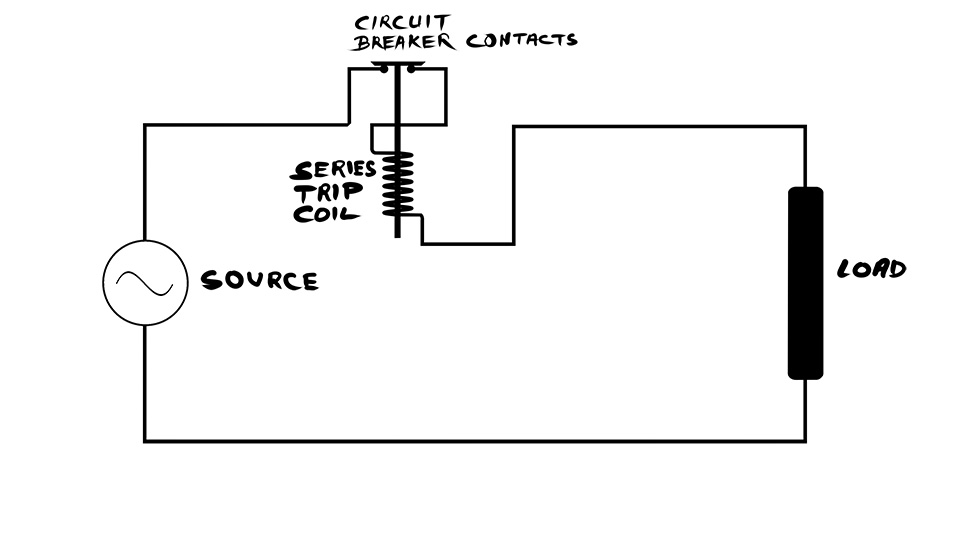Circuit breakers are essential protective devices of electrical power systems. A circuit breaker safeguards electrical circuits from abnormal conditions such as overloads and faults. Among different tripping arrangements, the shunt trip mechanism is the most popular method for ensuring safe and reliable operation in high-voltage systems. In this article, we will explain the theoretical working of the shunt trip mechanism, the function of the shunt trip coil, and compare it with the series trip mechanism.
Shunt Trip Mechanism
In the shunt trip mechanism, the tripping coil of the circuit breaker operates with the help of DC power. Therefore, it needs a separate DC circuit with a battery. The battery supplies power to the shunt trip coil, which opens the CB. Obviously, this auxiliary supply ensures that the tripping function does not depend on the main power circuit.

The arrangement consists of a CD circuit, a shunt trip coil, a current transformer, and a relay coil. The relay responds to the signal from the current transformer.
Working Principle of Shunt Trip Mechanism
- Suppose a fault occurs in the line. The fault current passes through the current transformer.
- Therefore, the current transformer senses the fault current and reproduces a proportional secondary current.
- As a result, the relay coil produces more magnetizing force.
- Then, this force closes the normally open contact in the DC circuit.
- Once the contact closes, DC voltage appears across the shunt trip coil.
- Lastly, the energized coil activates and trips the breaker by opening its contacts.
Thus, the shunt trip coil is the key element that converts fault detection into the mechanical opening of the breaker.
Tripping Action
In the simplified circuit, the plunger of the shunt trip coil is directly connected to the moving contact of the circuit breaker. In practice, however, there is a spring mechanism, or sometimes a hydraulic or pneumatic mechanism, that stores potential energy. When the trip coil becomes energized, it releases this stored energy by striking a plunger. This action ensures a very fast and reliable tripping of the circuit breaker.
Key Observation
We do not connect the shunt trip coil directly to the main circuit. Instead, we use a current transformer in series with the line, which actuates the relay. The relay then closes the DC trip circuit. As a result, the DC supply energizes the shunt trip coil, which initiates the opening of the breaker.
Series Trip Mechanism of Circuit Breaker
The series trip mechanism is an important operating principle in circuit breakers. In this mechanism, we connect the trip coil in series with the main circuit. Whenever current flows through the circuit, under normal current conditions, the trip coil produces a magnetic force. However, this magnetic force is not sufficient to move the plunger associated with the trip coil.
Working of the Series Trip Mechanism
During a fault condition, the current becomes large enough for the trip coil to create a sufficient magnetic force. This increased force moves the associated plunger. The plunger is mechanically attached to the moving contact of the circuit breaker. Hence, the movement of the plunger ultimately causes the movement of the moving contact. As a result, the circuit breaker opens and isolates the faulty zone from the healthy zone.
Here, we connect the trip coil in series with the circuit. If a fault occurs at a particular part of the power system, the fault current flows through both the circuit breaker contacts and the trip coil. Consequently, the magnetic force applied to the plunger increases. The increased force moves the plunger, which then strikes a spring-loaded lever in the circuit breaker operating mechanism. This action opens the circuit breaker and interrupts the fault current.

In the simplified diagram, we have shown the plunger directly coupled to the moving contact of the circuit breaker. However, in actual practice, this is not the case. Instead, there is a spring mechanism in between. This spring stores potential energy during the closing operation of the circuit breaker. When the plunger strikes with sufficient force, this stored energy is released to unlatch the mechanism and open the breaker.
For simplicity, we have not shown the detailed mechanism here. However, this explanation is sufficient to provide a basic understanding of the series trip mechanism of a circuit breaker.
Advantages of Series Trip Mechanism
There are some advantages of the series trip mechanism as well as the shunt trip mechanism. First, we shall discuss the advantages of the series trip mechanism. Here, we connect the trip coil in series with the power circuit. So, there is no additional requirement for an extra circuit for energizing the trip coil during a fault. This self-powered trip coil also simplifies the design complexity.
The design of the series trip coil is much simpler than that of the shunt trip mechanism, because in the latter case, a separate DC source, current transformer, and relaying part are required. The series trip is the simplest arrangement. For low-voltage and LT circuit breakers, we always prefer the series trip mechanism because it makes the construction of the circuit breaker quite compact.
But the series trip mechanism also has some disadvantages. If we compare it with the shunt trip mechanism, the disadvantages are more.
Disadvantages of Series Trip Mechanism:
- Size of the coil: The trip coil must maintain the same short-circuit withstand capability of the system.
- Load current through the coil: The trip coil carries the entire load current. Hence, the size of wires must be thick enough. Both these factors make the coil bulky for high-voltage ranges where current ratings are also higher.
- Insulation requirement: It is not possible to accommodate a series trip coil inside the mechanism of a circuit breaker for high-voltage systems. This is because in that case, the insulation requirement becomes much higher and hence uneconomical. Since the same insulation level as the high-voltage system has to be maintained inside the breaker mechanism, the trip coil is placed there.
- Power dependency: Since the trip coil is powered by the main circuit, if there is a power failure in the system, the circuit breaker will fail to trip.
Advantages of Shunt Trip Mechanism
The shunt trip mechanism has some disadvantages compared to the series trip mechanism, but it is a necessity in many systems. Even though a shunt trip mechanism is more complex and costlier than a series trip mechanism, it is still implemented in high-voltage breakers.
The foremost reason is that during a total blackout in a substation, the shunt trip mechanism remains active because a separate battery-stored DC source feeds it. Therefore, it works efficiently even under complete power failure conditions.
In high-voltage circuit breakers, the shunt trip is the only option. If we try to use a series trip mechanism in such cases, the coil size becomes extremely large due to the required insulation and the thick copper wire. Hence, using a series trip mechanism is not economical and practical for high-voltage systems.
Disadvantages of Shunt Trip Mechanism
Although the shunt trip mechanism is widely used, it has a few disadvantages:
- Additional power requirement: It needs a battery bank, battery charger, and DC distribution board with associated wiring. This separate system requires regular maintenance and additional expenditure.
- Failure risk: If any failure occurs in the DC system, the circuit breaker may fail to trip during fault conditions.
Despite these disadvantages, the advantages of the shunt trip mechanism always outweigh its drawbacks. Therefore, it is the most widely used tripping mechanism in high-voltage circuit breakers.
